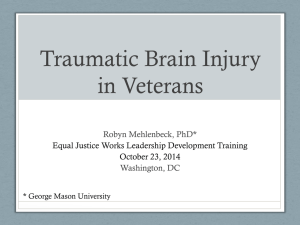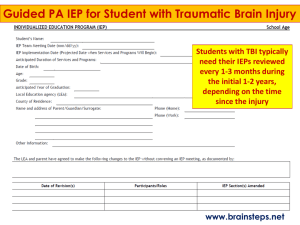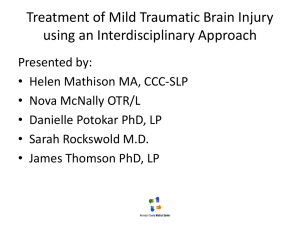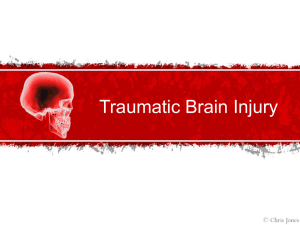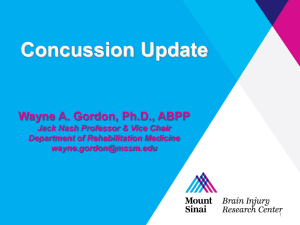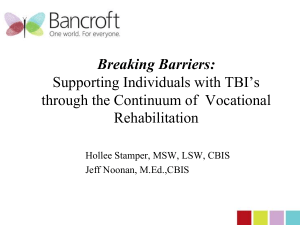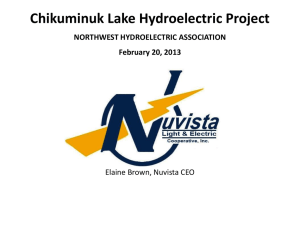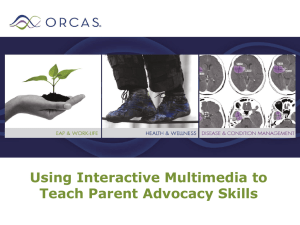Traumatic Brain Injury in Alaska
advertisement
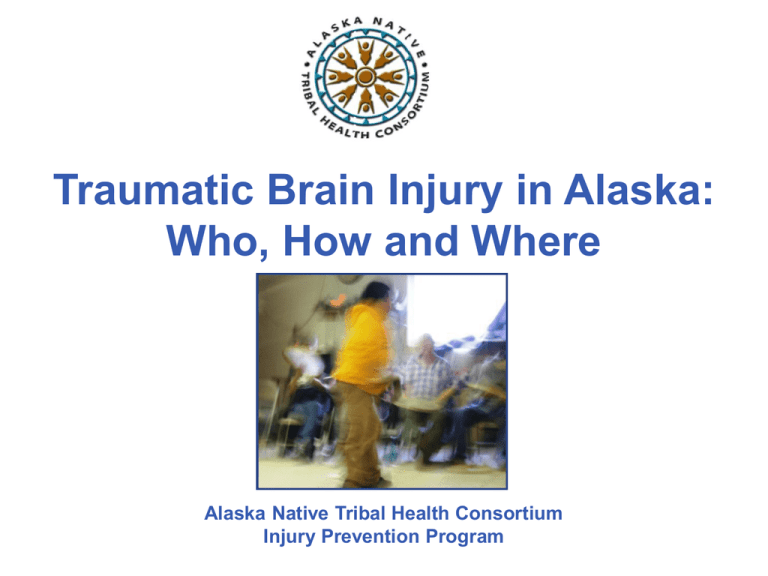
Traumatic Brain Injury in Alaska: Who, How and Where Alaska Native Tribal Health Consortium Injury Prevention Program What is a Traumatic Brain Injury? CDC describes it as: “…caused by a bump, blow, or jolt to the head or a penetrating head injury that disrupts the normal function of the brain.” How do you get a TBI? Many different kinds of events, some that are almost everyday events, can cause a TBI: Hitting your head when you fall or trip Crashing your bike, snow machine or ATV Being in a motor vehicle crash Injure your head during sports Being near an explosion How does a TBI affect you? If you or someone else gets a TBI, it can cause temporary or permanent changes in: Thinking (remembering and reasoning) Physical abilities (walking, coordination) Sensation (touch, taste, smell) Language (understanding, communication) Emotion (depression, aggression, anxiety) Increased Risk of TBI Who? The Gender Gap Rate of TBI Hospitalizations (injuries per 100,000 people) Non-fatal TBI Hospitalizations in Alaska 2004-2008 250 235 Males 200 150 Females 118 100 122 70 111 60 50 0 United States* Alaska, All races Alaska, AN/AI * US data for 2002-2006, per CDC Age Differences Non-fatal TBI Hospitalizations in Alaska 2004-2008 RATE OF TBI HOSPITALIZATION (per 100,000) 350 AN/AI 300 Non-native 250 200 150 100 50 0 AGE GROUPS Age groups and Activities Different age groups have different activities that result in the highest numbers of TBI: Ages (years) Activities with the most TBI 0-9 Falls 10-19 Motor vehicle, ATV/Snowmachine 20-39 Motor vehicle, Assault 40+ Falls, Motor vehicle Increased Risk of TBI Where? Region of Patient Residence Non-fatal TBI Hospitalizations in Alaska 2004-2008* All U.S. Rate**: 93 All Alaska Rate*: 92 Alaska Native Rate*: 174 * Crude rates, reported as TBI per 100,000 people ** All U.S. rate for 2002-2006, per CDC. Specific places of occurrence Non-fatal TBI Hospitalizations in Alaska 2004-2008 Residential Institution Other Recreation Sports Highway Industrial Place Public Place Home Increased Risk of TBI Is Alcohol a Risk Factor? Yes Alcohol Association by Age Non-fatal TBI Hospitalizations in Alaska 2004-2008 Percent of TBI hospitalizations for each age group associated with alcohol 60 50 40 30 20 10 0 Alcohol by Activity Non-fatal TBI Hospitalizations in Alaska, 2004-2008 ACTIVITY Cases associated with alcohol Assault 3 out of every 4 Suicide attempt and Snow machine 1 out of every 2 Pedestrian and All-terrain vehicle 2 out of every 5 Motor vehicle traffic 1 out of every 3 All other 1 out of every 5 Alcohol by Activity Non-fatal TBI Hospitalizations in Alaska 2004-2008 ACTIVITY Total Cases Per cent of cases associated with alcohol Assault 375 72% Snow machine 121 49% Suicide attempt 27 48% Pedestrian 108 41% All-terrain vehicle 240 39% Motor vehicle traffic 644 32% Bicycle 132 23% 1034 18% 408 18% Falls All other Increased Risk of TBI How severe? Time in Hospital For TBI hospitalizations from 2004-2008, the length of time patients spent in the hospital: Average: 5.6 days (compared to 3.9 for non-TBI injuries) Maximum: 305 days (10 months) Patient destination at discharge Non-fatal TBI Hospitalizations in Alaska 2004-2008 71 44 29 97 Home,No Assistance 83 Acute Care Hospital 162 Inpatient Rehabilitation Skilled Nursing 521 2082 Home,Rehab Outpatient Home,Health Care Left against medical advice (AMA) Other or unknown Patient’s General Condition on Discharge Condition Frequency % Good, Return to Previous Level of Function 861 28 Temporary Disability, Expected to Return to Previous Level of Function 1111 36 Moderate Disability with Self Care 133 4 Severe Disability, Dependent 155 5 Persistent Vegetative State 4 .1 Unknown 825 27 Risks of TBI How much $$? Hospitalization costs Hospitalization costs for TBI in all Alaska averages $29,000 per injury, compared to the $20,000 average for all injury hospitalizations Estimated total per year: $16.7 million Highest hospitalization cost for TBI: $1,010,000 Medivac costs These costs vary dramatically depending on the contract with the Medivac company. These are cost ranges Alaska companies provided for actual trips taken: Juneau to Seattle: $17,000 to $37,000 Anchorage to Seattle: $27,000 to $56,000 Nome to Seattle: $37,000 to $75,000 Anchorage to Richmond, VA: $63,000 to $124,000 Prevention What is being done? Snowmachine, ATV, and Motorcycle Safety Child Motor Vehicle Safety Reducing harm from guns Gun Safes Home Safety Survey Date: Resident: Assessment by: This Home Safety Survey is designed to look for hazards in and around the house so they can be fixed before they cause problems. Home safety problems could lead to unintentional injuries from falls, burns, or poisoning. Falls can be a major problem for an elder. Falling can result in serious injury or loss of independence. This survey can be done by a CHA/P, CHR, or a family member. YES NO Home Entrance Steps and walkways in good repair; no broken edges or boards or other hazard Secure ramp installed if resident uses a wheelchair or finds stairs difficult Exterior stairs and landing are slippery when wet Raising awareness Area on roof for ice/snow to accumulate and slide onto landing, stairs, or ramp Secure, sturdy railing on both sides that is easy to grasp with both hands Lights that light up a wide area of the yard and walkway Lock that does not need a key to open from inside (unless wandering is an issue) Mat, carpeting or textured floor in entryway to prevent slipping when wet Seat available for putting on and removing ice grippers or cleats Living Areas Doorways wide enough to use a walker, a wheelchair, or if carrying a load Open pathways with no small furniture, clutter, or "stuff" Throw rugs or mats Thresholds between rooms/floor textures are smooth with visible color contrast Electric phone cords running under rugs or carpeting or across open areas Frayed electric cords Electric outlets and switches overloaded (warm to the touch) Lights can be turned on without walking across a dark room Ice cleats Home modification ANTHC Traumatic Brain Injury Contacts Jaylene Wheeler, Injury Prevention Coordinator (907) 729-3799 jzwheeler@anthc.org Hillary Strayer, Senior Injury Prevention Specialist (907) 729-3513 hdstrayer@anthc.org Website: http://www.anthc.org/chs/wp/injprev/ Thank you!

